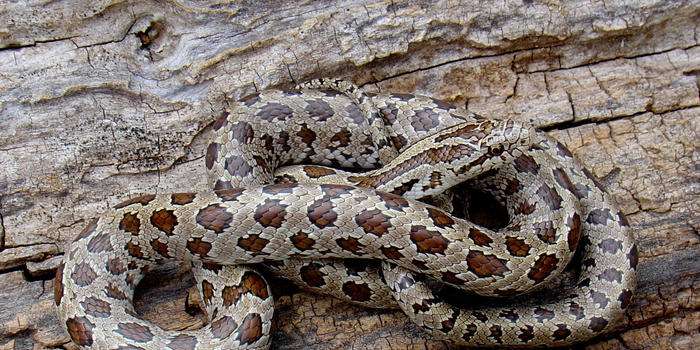Common US snake actually three different species

New research reveals that a snake found across a huge swath of the Eastern United States is actually three different species. Published in the journal Molecular Phylogenetics and Evolution, analyses of the yellow-bellied kingsnake (Lampropeltis calligaster) also indicate that diversification of the snake—and possibly of many other vertebrates living on both sides of the Mississippi River—is influenced not by the river itself, as predominately thought, but by the different ecological environments on each side.
"Not only have we uncovered multiple species, but we're making steps toward understanding the mechanisms that are generating biodiversity in the United States," said Frank Burbrink, an associate curator in the Museum's Department of Herpetology who conducted the study with Alexander McKelvy from the City University of New York's College of Staten Island. "Even though the U.S. has been explored scientifically for more than 200 years, we still don't fully know what's in our backyard."
The yellow-bellied kingsnake, also called the prairie kingsnake, has an extremely large range spanning from Nebraska to Virginia in the north and from Texas to Florida in the south. There are three subspecies of the snake, two of which started as distinct species when they were first discovered and then demoted after more study. But the new genetic and ecological analysis elevates them back to individual species with specific habitats: L. calligaster in the prairies west of the Mississippi River, L. rhombomaculata in the forests east of the Mississippi, and L. occipitolineata in South Florida wet prairies.
Speciation is often caused by geographic barriers like mountain ranges or bodies of water that prevent animals from breeding with their counterparts on the other side. Over time, each group evolves separately. The prevailing hypothesis is that the Mississippi River was instrumental in generating biodiversity in eastern North America. The new study, however, challenges that idea, suggesting that diversification was the result of the drastically different ecosystems the snakes inhabit, not the river itself.
"You go from the forest to the grasslands and 'voila!', you make a different species," said Burbrink, who has also studied this effect in copperhead snakes.
The results of the study are vital to conservation efforts because where there was once a very large population of a single wide-ranging species, there are now three species with considerably smaller numbers. The authors point out that the Florida species, L. occipitolineata, is particularly at risk, and has plenty of company. Urbanization of the Florida landscape since 1960 has been faster than anywhere else in the U.S., with human population doubling every 20 years.
"It's likely that this diversification mechanism applies to more than just snakes," Burbrink said. "All of the animals that have a range over these areas should probably be re-studied."
More information: A.D. McKelvy et al, Ecological divergence in the yellow-bellied kingsnake (Lampropeltis calligaster) at two North American biodiversity hotspots, Molecular Phylogenetics and Evolution (2017). DOI: 10.1016/j.ympev.2016.09.006
Journal information: Molecular Phylogenetics and Evolution
Provided by American Museum of Natural History


















